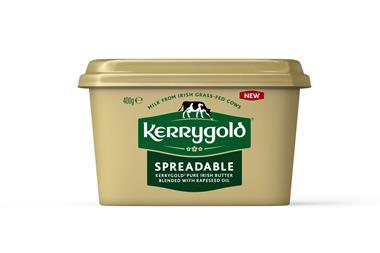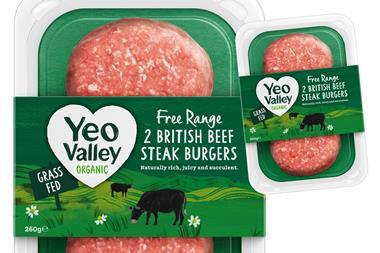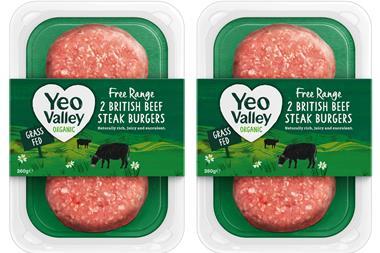Colourful indulgence in yoghurts and pot desserts is booming - but suppliers also have to meet concerns about waistlines…
Take a look at yoghurts and desserts and you’d be forgiven for thinking Willy Wonka had joined the dairymen. Brands and own-label suppliers are churning out seriously indulgent NPD, adding chocolate, biscuit pieces and confectionery to products as they seek to satisfy consumers’ increasingly sweet tooth.
Nestlé last month launched its first-ever Quality Street pot dessert - a Toffee Penny variant - and yoghurt is no different: for example, Sainsbury’s introduced indulgent Eton mess, key lime pie, apple crumble and banoffee pie yoghurts earlier in the year.
What’s driving this focus on sweetness? And, with overall yoghurts and desserts sales growth sluggish at 3.5% in value and down 2.3% in volume [Kantar Worldpanel 52 w/e 10 June 2012], is sweet NPD the right strategy?
It’s certainly working for pot desserts. Lactalis Nestlé says its Aero-branded mousse range and Rolo-branded chocolate pot desserts were the most successful products in its chilled desserts portfolio in the past 12 months, while Cadbury’s limited-edition Mini Eggs twin-pot dessert - produced by Müller - accounted for 35% of all sales in the twin-pot category in the 14 weeks it was on sale in the run-up to Easter.
These individual successes are reflected in the performance of chilled desserts as a whole. Their value sales rose by 4.2% year-on-year to just over £667m, with volumes up 0.1% to 169 million kg, while yoghurt value sales rose by 3.1% to £1.3bn, with volumes down 3% to 575 million kg [Kantar].
“Yoghurts carry a halo of health. Combine that with a dessert and you have hit the mark” Steve Clarke, Lactalis Nestlé
With desserts outperforming yoghurts, suppliers are understandably focusing on ramping up the desserts credentials of their yoghurts.
Consumers want to treat themselves but also have their waistlines in mind, says Steve Clarke, marketing director at Lactalis Nestlé Chilled dairy. “Yoghurts carry a halo of health,” he adds. “If you can combine that with a dessert, you have hit the mark.”
Clarke believes dessert flavours can even attract new shopper groups to yoghurt and launched Yorkie and Rolo-branded yoghurt split pots in March. “We see an opportunity for teenagers and men, and the split pots are starting to gain traction,” he says.
The trend for indulgence is also reflected more widely in the flavour combinations, and sweet, exotic flavours are fast becoming the category’s go-to flavours. Emmi is planning to launch an orange and fig variant for its Onken big pot range in November, while Müller is adding a chocolate orange crunch limited edition to its Corner range this month, along with a cookies and cream variant, while Lactalis Nestlé is set to introduce a mango variant to its Ski mousse range in November.
Greek
Interest in Greek and Greek-style yoghurt is also lively. According to BrandView.co.uk, 40 new Greek and Greek-style SKUs have hit the mults in the past 12 months alone [52 w/e 5 August 2012], from Müller’s Müllerlight Greek Style range (launched in March) and Danone’s new Oykos brand (launched in May) to variants from Total and Yeo Valley as well as many own-label launches.
Elsewhere in the category, sweet, indulgent notes are also being introduced. Danone added a coconut variant to its Activia Intensely Creamy range in July, complete with an on-pack ‘Temptations’ flash, while Müller says its Müllerlight coconut with chocolate sprinkles limited edition, launched last autumn, proved such a hit with shoppers it’s now permanent.
Own-label competition
Brands have to keep a particularly close eye on competition from own-label lines. In the past year, the mults have invested heavily in revamping their ranges. Tesco rolled out new, colourful packaging and added new variants to its standard-tier yoghurts. Morrisons boosting its yoghurts range with improved recipes and 20 new lines earlier in the year. And, in addition to launching dessert-style yoghurts, Sainsbury’s converted its yoghurts to new By Sainsbury’s branding in May and refreshed its big pots.
“The fruited big pot range has been rejuvenated in both flavours and pot format, moving from card to printed clear pots,” says buyer Peter Ward.
The investment in own-label lines is paying off. Though brands continue to account for the bulk of the total yoghurts and desserts markets, own label is showing far more impressive growth rates, with value sales for yoghurt up by 19.6% to £288m over the past year and volume up by 13.1% to 161m kilos. Similarly, own-label desserts lines have grown by 5.4% in value, to £400m, and 2.6% in volume, to 94.7 million kilos [Kantar].
By contrast, during the same period, branded yoghurt sales slumped by 0.7% in value, to just over £1bn, and 8% in volume, to 414 million kg, while desserts sales were up 2.4% in value, to £266m, and down 3% in volume, to 74.6 million kg.
The effects of heavier own-label investment are being felt across most yoghurts and desserts categories, but big pot suppliers have seen an especially sharp increase in competition.
“In the last 12-18 months many multiples have gone from offering no big pot private yoghurt ranges at all to introducing not only a big pot yoghurt range of their own, but also a premium own-label big pot range,” says Steve Johnson, UK manager of Twekkelo Farmhouse Yoghurts.
It’s not difficult to see why. Popularised by Onken, Rachel’s, Yeo and other premium brands, the big pot sub-category has far outperformed the wider yoghurts and desserts market in the past 12 months, clocking up a 13.4% value sales increase to £384.7m and a 9.2% rise in volume [Kantar].
Big pots are doing well because value-conscious shoppers see them as offering better value than single pots, says Johnson, and branded suppliers are confident they can capitalise on this despite increased competition from own label.
Emmi UK marketing manager Laura Graham says Onken value sales are up 11% year-on-year, with growth accelerating since the company revamped its range and removed artificial sweeteners earlier in the year. In addition to tapping into the trend for indulgence with its latest Onken variants, Emmi has also ramped up investment in the brand, launching a £2m TV campaign in June.
Away from big pots, Lactalis Nestlé has identified mousses - a sub-category traditionally focused on permissible indulgence - as offering untapped opportunities. “We entered the market with Ski mousse in strawberry and lemon flavours in January,” says Clarke. “That’s been the biggest launch in the category. There are no real branded mousses - there was a gap.”
The way forward for brands has to be in developing new products and pack formats to meet “consumers’ changing lifestyle needs, flavour innovation and investment in marketing support,” concludes Colin Smith, Müller Dairy’s commercial director.
It’s a daunting task but one which looks set to be sweetened by plenty of indulgent NPD. Of course, Roald Dahl fans will know Willy Wonka had only five golden tickets up for grabs - only time will tell whether brands or own label will get to them first.


















No comments yet